June 06, 2023
Is your digital business actually thriving and delivering value?
The share of digital business has been booming for many companies in recent years. For many, the COVID pandemic accelerated what was already an ongoing trend. Digital offerings have been developed and refined, and the digital footprint has been established and expanded. However, COVID-related acceleration of digital has largely halted as macro-economic conditions have changed.
Now is the time for reflection: a digital reality check.
Many people working with digital business are at a crossroads right now. Some have just invested massively in a first push towards digital, some face the fourth or fifth digital transformation program and some have a digital business running on fumes looking to make a digital turn-around. Some are even questioning the imperative for the current digital investment level.
The reality check
At Valtech, we’ve written about growth based on being lucky or being good before. We’ve recently talked about the digital business leadership challenge. Today, we want to talk to you about another fundamental question: Is your digital business worth it?
In the digital landscape, multiple factors such as organizational complexity, the amount and importance of data, the number of new technologies and the speed at which they are adapted are still on the rise. The same can be said about investments into digital; many businesses have invested heavily into talent, acquisition of companies, internal innovation efforts, the list goes on and on. But the growth of the digital business of the last eight to ten years is now slowing down in many companies.
The time of “growth at all costs” is over. Many leaders and companies are left with uncomfortable questions: Is digital worth it? What value does it create? Will you be able to create enough value and profit long term? Answering these questions requires you to reflect upon the return on investment of your digital business.
Focus on outcome
It’s tempting to continue existing projects with some tweaks, having the same internal discussions, prolonging roadmaps and adjusting budgets. We would argue you’re now (and have always been) better off by regularly taking a step back to focus rigorously on outcomes first. Everything on your digital agenda should be strictly outcome-focused with a solid business case to back it up. Yes, your business needs to be customer-driven, and have a data-driven focus etc., but, it must always start with the return on investment in mind.
So, the question becomes: Are you delivering outcomes according to expectations? Or in other words, how is your digital business actually doing? To address this question, we recommend reflecting upon three key areas: value, creation and transparency.
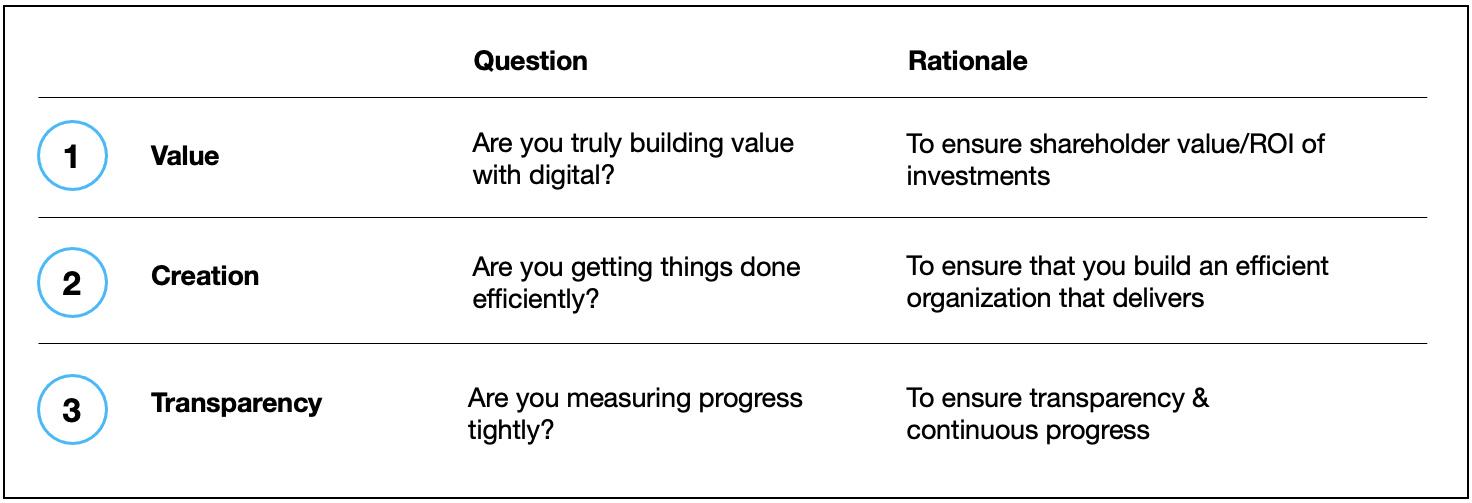
The three key areas to investigate, to assess how your digital business is doing.
1. Value
Are you truly building value with digital? Discussions on this topic can be very theoretical, but they don’t need to be. And to be honest, it is the most important of all questions. But why do we spend so little time on it. Most often, it’s is because this is conceived as an uncomfortable questioning of the current strategy and can potentially lead to big internal changes. But you should spend time on it. And if you don’t, you will be faced with the consequences at a later stage no matter what.
A good way to cut through the noise and get a clear answer on whether you are building value, is to look at value as if you were to sell your business and would need to provide answers for a potential buyer. Even though this is often not the actual intent, looking at your digital business through this lens is very helpful to ensure that you build true value through your current prioritization and the outcomes you are focused on delivering.
- This would typically imply that you’d look at the following areas:
- Are you gaining market share and growing in core focus segments of your business?
- Do you have a proven track record of efficiently acquiring new and retaining existing customers?
- Are you able to cross- and upsell products and services to existing customers?
Below, you will find an example of what these could look like for a D2C/ecommerce business – the KPIs that buyers of digital businesses would typically look at. Some of them might be in your internal reporting already but some might not, – and often the longer perspective and track-record is not being looked at due to short term focus on weekly performance etc.
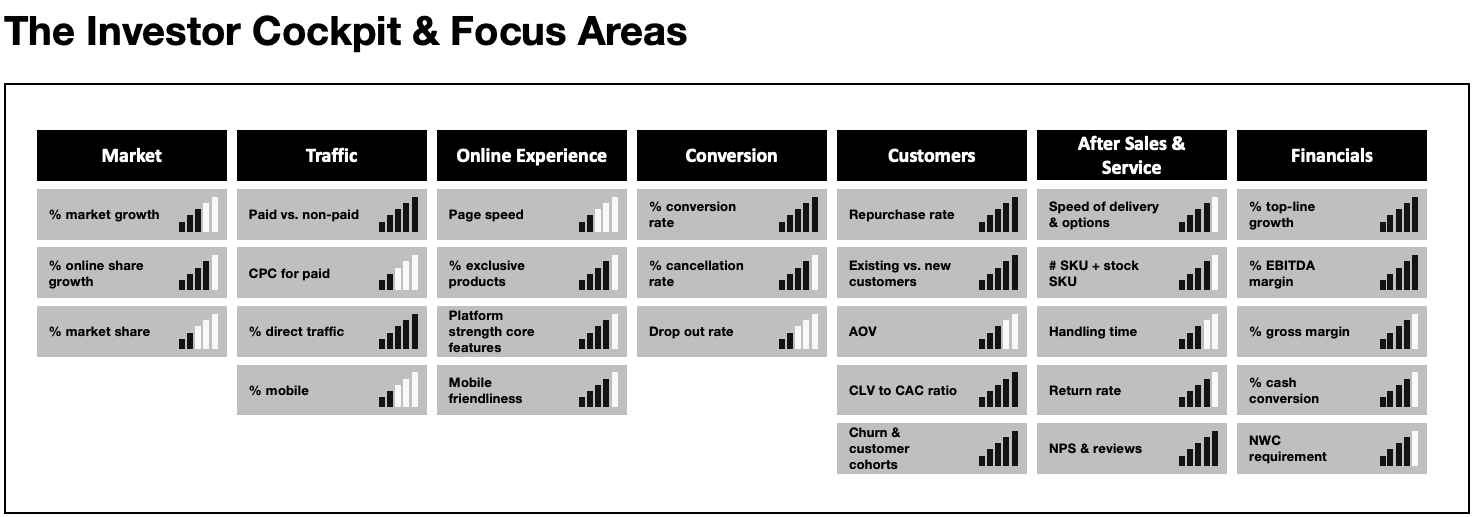
Example of an investor cockpit and focus areas: the factors to reflect on in the ‘if we were to sell’ perspective.
Of course, the investor driven perspective is not exhaustive. There are additional indicators of value, beyond the narrow digital business you are developing. In most cases, your digital business provides value for the rest of the core business as well – which is not reflected in the “if you were to sell” perspective above. A way to include this into your reflection process, would be to look at the set of key drivers of business value within your company and map out how your digital efforts support each of these. Roughly speaking, this would imply that you look at how digital enables you to preserve and optimize costs, retain current customers and grow your business (as illustrated below). As with the “if you were to sell” perspective, look at this to analyze if you are focusing oin the right areas and creating value, compared to the investments and operational costs going into it.
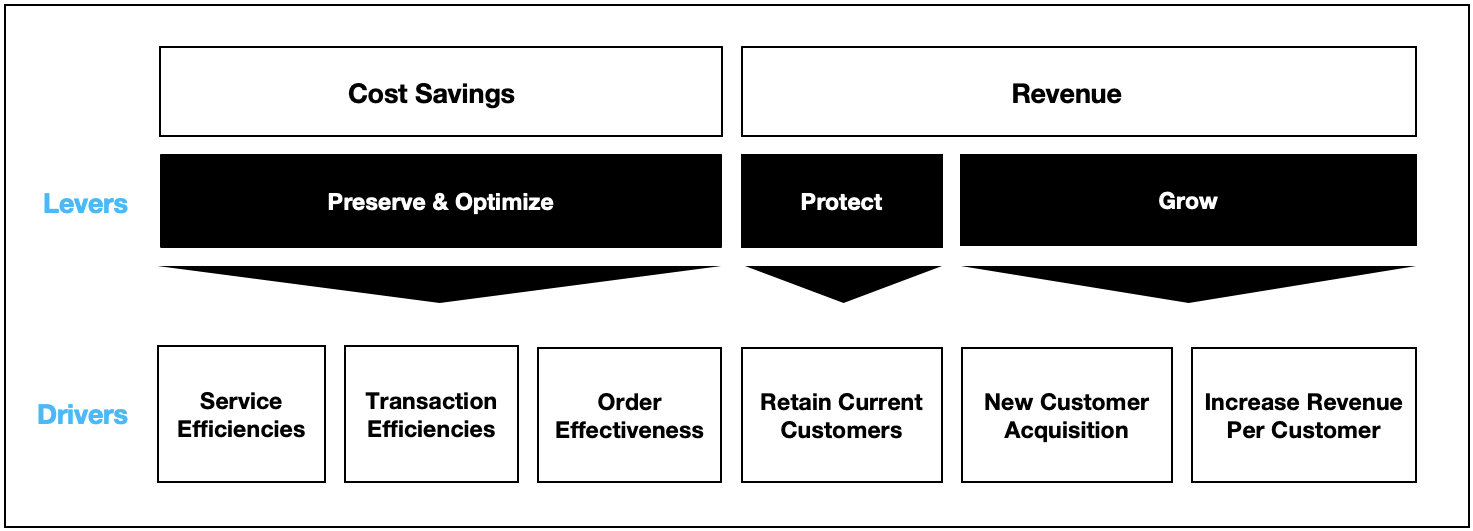
2. Creation
Now that you’ve created a coherent picture of whether you are focusing on true value, it’s time to look at the second area: the ability to create value.
This is all about execution and speed. Are you running a business that is effective in execution? Is your organization getting things done? The perspectives on execution are plentiful and well expanded on in business management literature. To make it tangible, it often boils down to your ability to simplify things and get the right pace into the way you operate.
The balance between “doing things right” and “doing the right things” is crucial here. Doing things right, but doing the wrong things, means your efforts will lack fundamental impact. It can be tempting to spend a lot of time, as an organization, on doing things right: focusing on the procedures and processes associated with running your business. This is not the way to become a value adding digital business. Focusing so much time on doing things right rarely leads to the “best” way of doing things. What really moves the needle needs to be the center of gravity “doing the right things”. Everything else needs to be treated with less focus.

Doing things right is important, but should never eclipse doing the right things
Now let’s talk about speed. In our experience, you can’t realistically execute more than three major changes or activities at a time. After all, there is a reason why many leaders advocate the power of three (some even tend to stick with two). However, most don’t comply with it in reality, – leading to a lack of executional focus. Things mushroom and are not stopped.
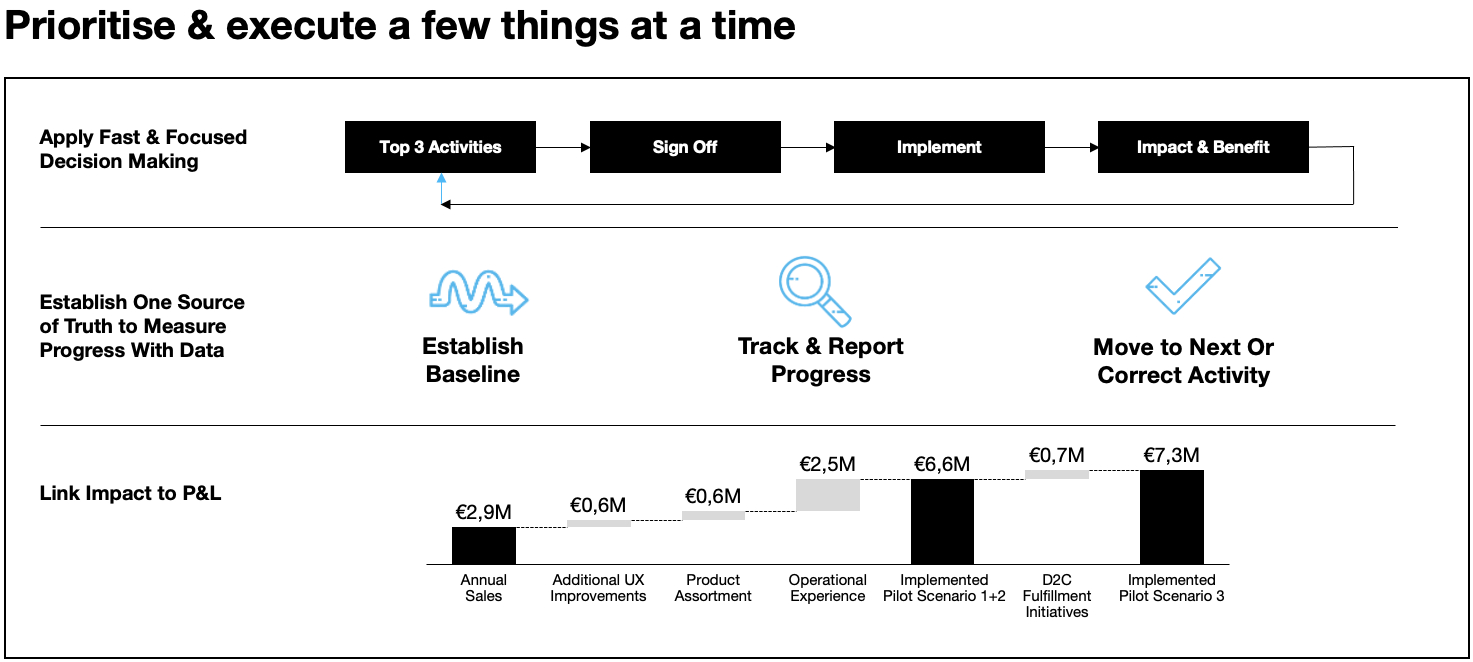
Dare to choose what to execute now, and explicitly what not to.
3. Transparency
Lastly, reflect on how transparently your business is operating when it comes to the progress towards business value. This can be done by asking yourself: Are you actually following and measuring progress systematically within your digital business? And is that done in a manner that ensures everyone understands how they’re contributing, to which targets and why that is an integral part of your overall company’s strategy?
How can you measure the value of digital internally? Chances are your company already has an extensive, classic strategy deck floating around, and the ambitions to match it. What’s often less clear, is how to link that strategy to business value drivers. Setting the right KPIs is crucial here. In fact, it’s the only way to ensure your strategy becomes executional. That’s why setting up a KPI framework is your first step when it comes to measurement — if you haven’t already. Besides not aligning KPIs to value, the most common pitfall here is that you are either using standard KPI’s or your overall digital/company dashboard is a compromise of KPI’s that make sure all individual departments have a role and preferable KPI that fits what they are already doing (provocative). This inside out approach is not the way to unlock value. Choose the right objectives for you — even if they can be complicated to measure!
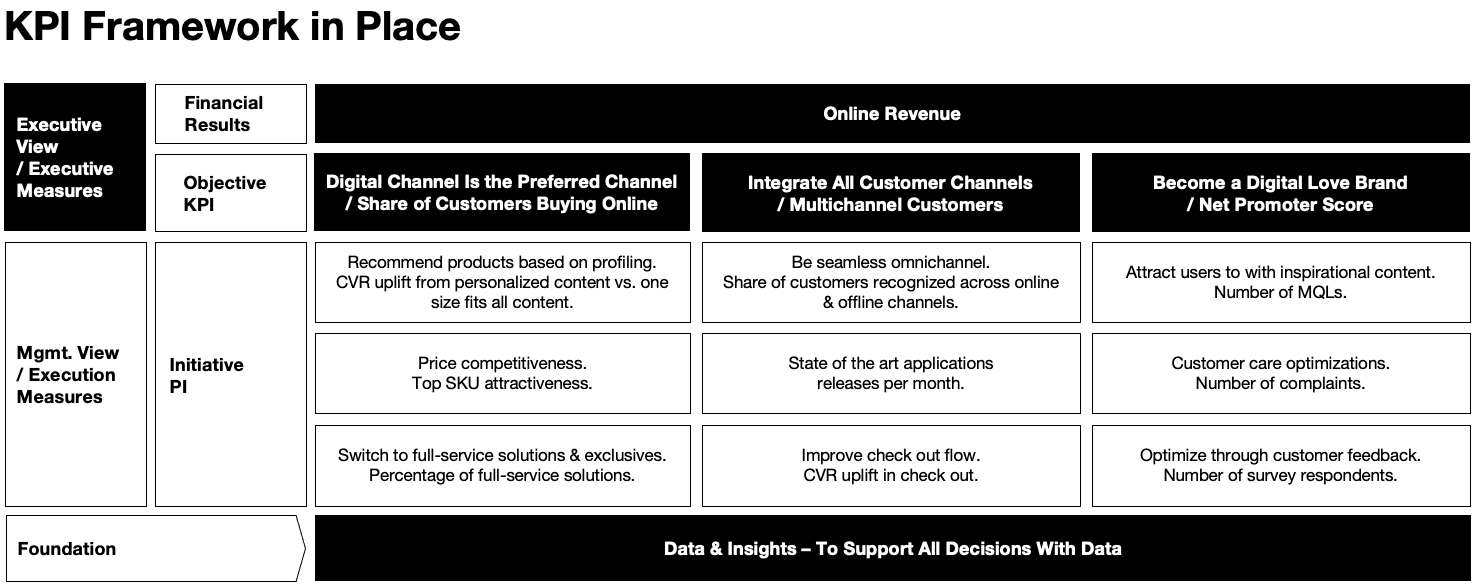
Example of a KPI framework. Ensure this is thought through and can be tracked in detail. Of course, other frameworks, such as OKRs, could work here as well.
The next step is to create strategic initiatives that belong to the objectives, and tie them to the value drivers and KPIs. These are your “road to get there”. Now that you know the initiatives, it’s time to look at prioritization. As we’re advocating for taking the outcome-focused perspective, our advice is to build business cases to estimate the potential opportunity of each of the epics – based on your data set, supplemented with benchmark numbers. This begs the question: Should you prioritize those initiatives that make the most short-term commercial impact? Well, it depends. Alongside the business case, you’ll want to do a feasibility check, in which you assess the prerequisites or efforts to execute the initiatives. Both the business case and feasibility should factor into your prioritization in the end. You might end up prioritizing some initiatives that make (slightly) less commercial impact, but are easy to execute.
The efforts detailed above, are by no means meant as a one-off assignment. The KPI framework and the progress measurement need to be refined on a regular (for example quarterly) basis. Don’t underestimate the importance of tracking the status of the strategy execution. And again, our advice is to think of it from an “if you were to sell” perspective, to keep you sharp and focused.
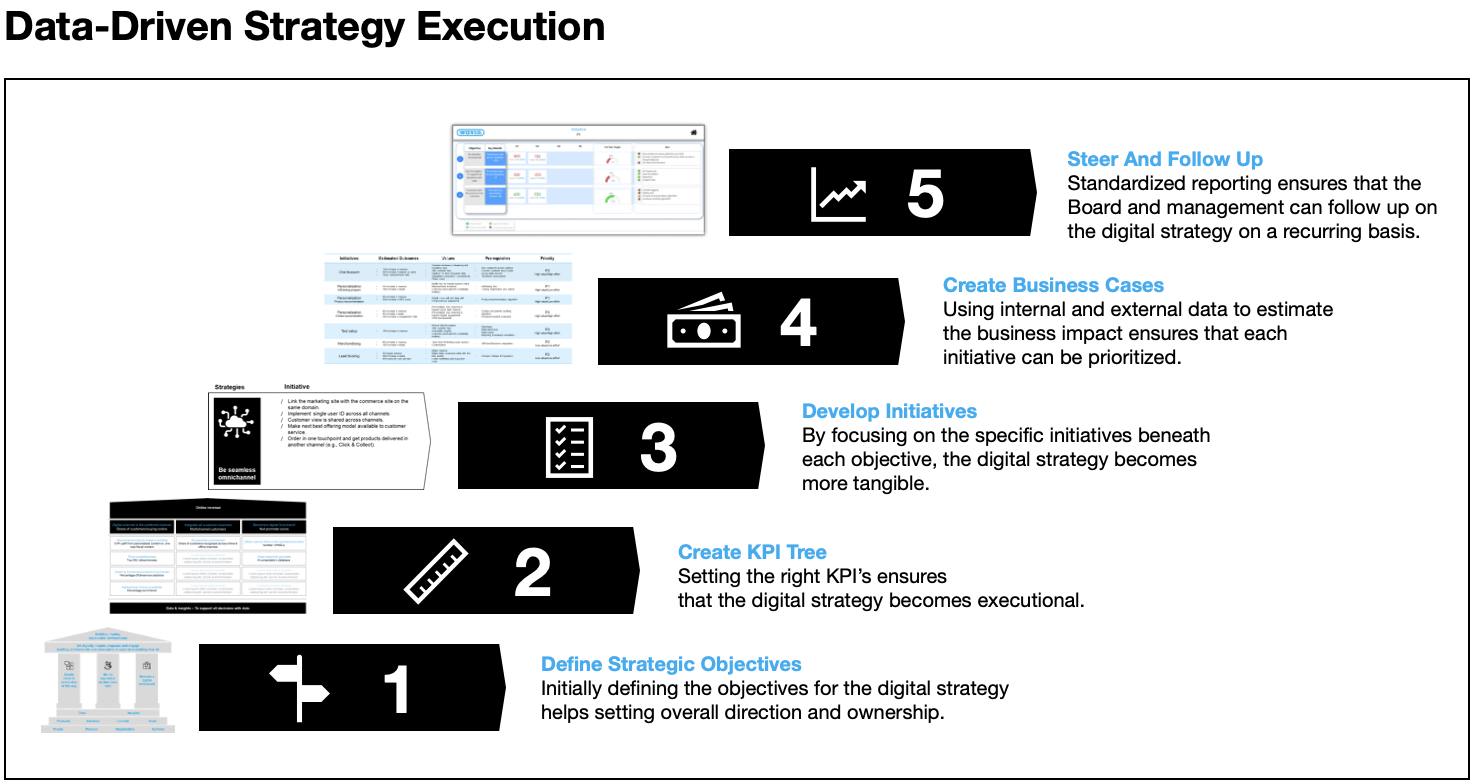
The step-by-step process of data driven strategy execution
Key takeaways
It is time for a reality check in digital in most organizations. The sole reason for this is that external factors have changed at a scale that we’ve not seen for many years. You might have the right focus on value creation and transparency, but do you truly know? For most companies, making minor adjustments and cutting costs here and there is just not the right answer.
- Our advice is simple:
- Do the reality check – don’t skip it. When conducting your check, focus on value and outcomes.
- Then make your prioritizations based on your company-specific conclusions.
In case you’re in doubt about how to get started, we’ve created a short list of the key questions to start asking first.










